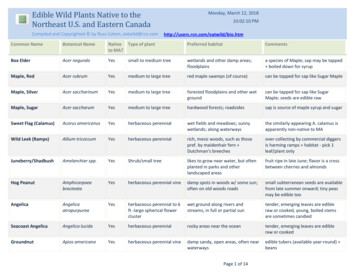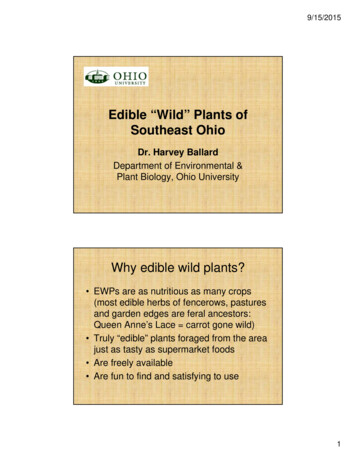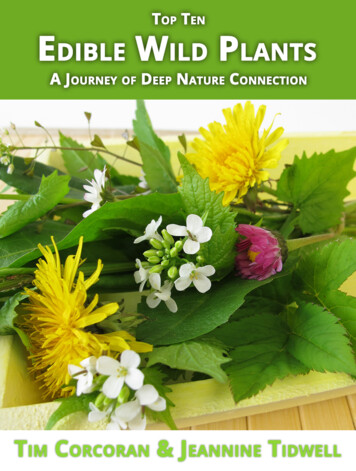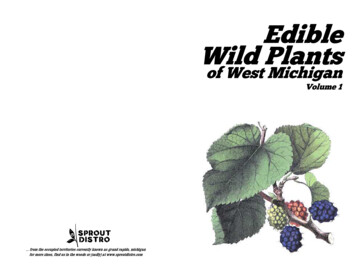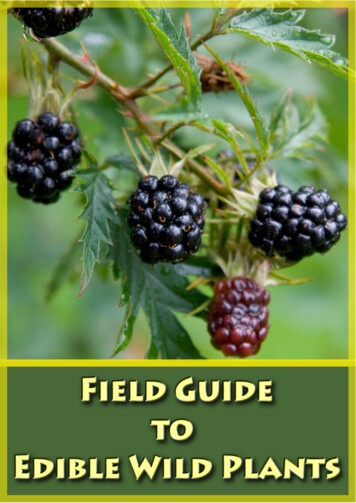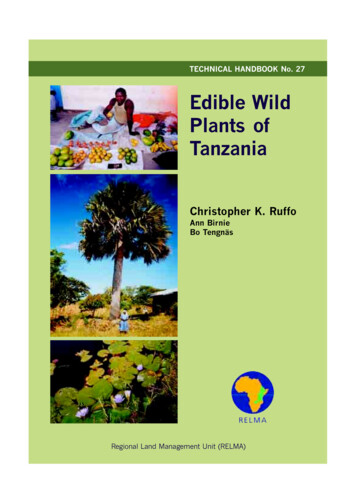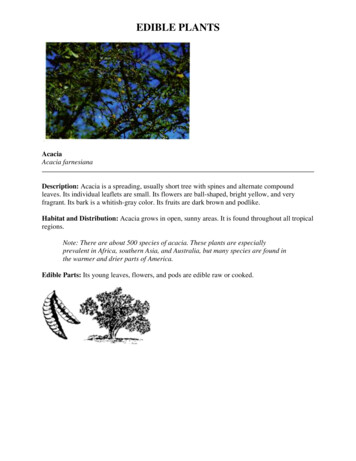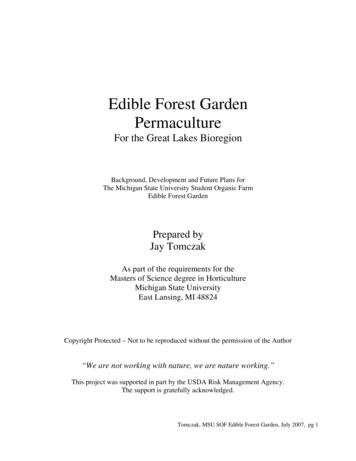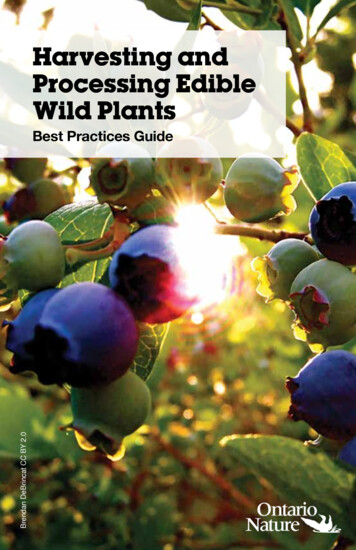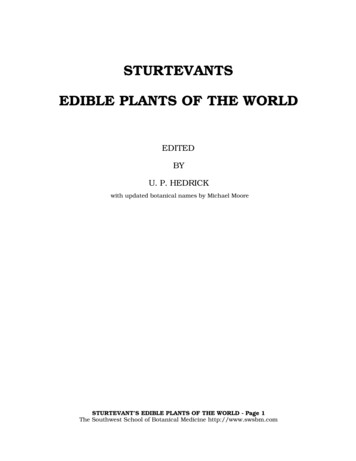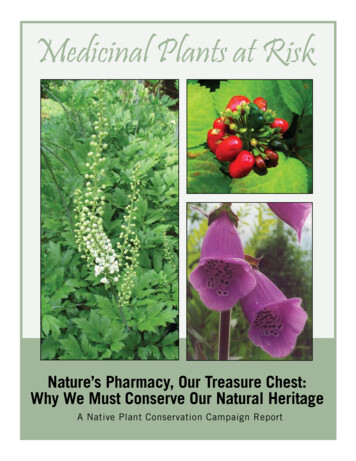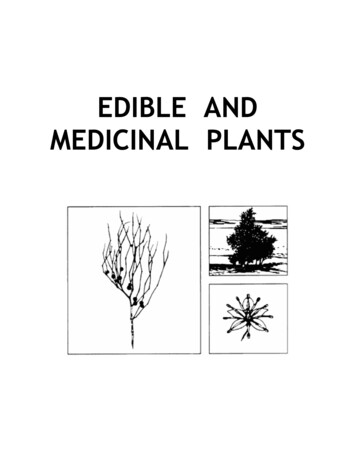
Transcription
EDIBLE ANDMEDICINAL PLANTS
AbalCalligonum comosumDescription: The abal is one of the few shrubby plants that exists in the shadydeserts. This plant grows to about 1.2 meters, and its branches look like wisps from abroom. The stiff, green branches produce an abundance of flowers in the early springmonths (March, April).Habitat and Distribution: This plant is found in desert scrub and waste in any climaticzone. It inhabits much of the North African desert. It may also be found on the desertsands of the Middle East and as far eastward as the Rajputana desert of western India.Edible Parts: This plant's general appearance would not indicate its usefulness to thesurvivor, but while this plant is flowering in the spring, its fresh flowers can be eaten.This plant is common in the areas where it is found. An analysis of the food value ofthis plant has shown it to be high in sugar and nitrogenous components.
AcaciaAcacia farnesianaDescription: Acacia is a spreading, usually short tree with spines and alternatecompound leaves. Its individual leaflets are small. Its flowers are ball-shaped, brightyellow, and very fragrant. Its bark is a whitish-gray color. Its fruits are dark brownand podlike.Habitat and Distribution: Acacia grows in open, sunny areas. It is found throughoutall tropical regions.Note: There are about 500 species of acacia. These plants are especially prevalent inAfrica, southern Asia, and Australia, but many species are found in the warmer anddrier parts of America.Edible Parts: Its young leaves, flowers, and pods are edible raw or cooked.
AgaveAgave speciesDescription: These plants have large clusters of thick, fleshy leaves borne close tothe ground and surrounding a central stalk. The plants flower only once, then die.They produce a massive flower stalk.Habitat and Distribution: Agaves prefer dry, open areas. They are found throughoutCentral America, the Caribbean, and parts of the western deserts of the United Statesand Mexico.Edible Parts: Its flowers and flower buds are edible. Boil them before eating.CAUTIONThe juice of some species causes dermatitis in some individuals.Other Uses: Cut the huge flower stalk and collect the juice for drinking. Some specieshave very fibrous leaves. Pound the leaves and remove the fibers for weaving andmaking ropes. Most species have thick, sharp needles at the tips of the leaves. Usethem for sewing or making hacks. The sap of some species contains a chemical thatmakes the sap suitable for use as a soap.
AlmondPrunus amygdalusDescription: The almond tree, which sometimes grows to 12.2 meters, looks like apeach tree. The fresh almond fruit resembles a gnarled, unripe peach and grows inclusters. The stone (the almond itself) is covered with a thick, dry, woolly skin.Habitat and Distribution: Almonds are found in the scrub and thorn forests of thetropics, the evergreen scrub forests of temperate areas, and in desert scrub andwaste in all climatic zones. The almond tree is also found in the semidesert areas ofthe Old World in southern Europe, the eastern Mediterranean, Iran, the Middle East,China, Madeira, the Azores, and the Canary Islands.Edible Parts: The mature almond fruit splits open lengthwise down the side, exposingthe ripe almond nut. You can easily get the dry kernel by simply cracking open thestone. Almond meats are rich in food value, like all nuts. Gather them in largequantities and shell them for further use as survival food. You could live solely onalmonds for rather long periods. When you boil them, the kernel's outer coveringcomes off and only the white meat remains.
AmaranthAmaranthus speciesDescription: These plants, which grow 90 centimeters to 150 centimeters tall, areabundant weeds in many parts of the world. All amaranth have alternate simpleleaves. They may have some red color present on the stems. They bear minute,greenish flowers in dense clusters at the top of the plants. Their seeds may be brownor black in weedy species and light-colored in domestic species.Habitat and Distribution: Look for amaranth along roadsides, in disturbed wasteareas, or as weeds in crops throughout the world. Some amaranth species have beengrown as a grain crop and a garden vegetable in various parts of the world, especiallyin South America.Edible Parts: All parts are edible, but some may have sharp spines you should removebefore eating. The young plants or the growing tips of alder plants are an excellentvegetable. Simply boil the young plants or eat them raw. Their seeds are verynutritious. Shake the tops of alder plants to get the seeds. Eat the seeds raw, boiled,ground into flour, or popped like popcorn.
Arctic willowSalix arcticaDescription: The arctic willow is a shrub that never exceeds more than 60centimeters in height and grows in clumps that form dense mats on the tundra.Habitat and Distribution: The arctic willow is common on tundras in North America.Europe, and Asia. You can also find it in some mountainous areas in temperateregions.Edible Parts: You can collect the succulent, tender young shoots of the arctic willowin early spring. Strip off the outer bark of the new shoots and eat the inner portionraw. You can also peel and eat raw the young underground shoots of any of thevarious kinds of arctic willow. Young willow leaves are one of the richest sources ofvitamin C, containing 7 to 10 times more than an orange.
ArrowrootMaranta and Sagittaria speciesDescription: The arrowroot is an aquatic plant with arrow-shaped leaves andpotatolike tubers in the mud.Habitat and Distribution: Arrowroot is found worldwide in temperate zones and thetropics. It is found in moist to wet habitats.Edible Parts: The rootstock is a rich source of high quality starch. Boil the rootstockand eat it as a vegetable.
AsparagusAsparagus officinalisDescription: The spring growth of this plant resembles a cluster of green fingers. Themature plant has fernlike, wispy foliage and red berries. Its flowers are small andgreenish in color. Several species have sharp, thornlike structures.Habitat and Distribution: Asparagus is found worldwide in temperate areas. Look forit in fields, old homesites, and fencerows.Edible Parts: Eat the young stems before leaves form. Steam or boil them for 10 to 15minutes before eating. Raw asparagus may cause nausea or diarrhea. The fleshy rootsare a good source of starch.WARNINGDo not eat the fruits of any since some are toxic
Bael fruitAegle marmelosDescription: This is a tree that grows from 2.4 to 4.6 meters tall, with a dense spinygrowth. The fruit is 5 to 10 centimeters in diameter, gray or yellowish, and full ofseeds.Habitat and Distribution: Bael fruit is found in rain forests and semievergreenseasonal forests of the tropics. It grows wild in India and Burma.Edible Parts: The fruit, which ripens in December, is at its best when just turningripe. The juice of the ripe fruit, diluted with water and mixed with a small amount oftamarind and sugar or honey, is sour but refreshing. Like other citrus fruits, it is richin vitamin C.
BambooVarious species including Bambusa, Dendrocalamus, PhyllostachysDescription: Bamboos are woody grasses that grow up to 15 meters tall. The leavesare grasslike and the stems are the familiar bamboo used in furniture and fishingpoles.Habitat and Distribution: Look for bamboo in warm, moist regions in open or junglecountry, in lowland, or on mountains. Bamboos are native to the Far East (Temperateand Tropical zones) but have bean widely planted around the world.Edible Parts: The young shoots of almost all species are edible raw or cooked. Rawshoots have a slightly bitter taste that is removed by boiling. To prepare, remove thetough protective sheath that is coated with tawny or red hairs. The seed grain of theflowering bamboo is also edible. Boil the seeds like rice or pulverize them, mix withwater, and make into cakes.Other Uses: Use the mature bamboo to build structures or to make containers, ladles,spoons, and various other cooking utensils. Also use bamboo to make tools andweapons. You can make a strong bow by splitting the bamboo and putting severalpieces together.CAUTIONGreen bamboo may explode in a fire. Green bamboo has an internal membrane youmust remove before using it as a food or water container.
Banana and plantainMusa speciesDescription: These are treelike plants with several large leaves at the top. Theirflowers are borne in dense hanging clusters.Habitat and Distribution: Look for bananas and plantains in open fields or margins offorests where they are grown as a crop. They grow in the humid tropics.Edible Parts: Their fruits are edible raw or cooked. They may be boiled or baked. Youcan boil their flowers and eat them like a vegetable. You can cook and eat therootstocks and leaf sheaths of many species. The center or "heart" or the plant isedible year-round, cooked or raw.Other Uses: You can use the layers of the lower third of the plants to cover coals toroast food. You can also use their stumps to get water (see Chapter 6). You can usetheir leaves to wrap other foods for cooking or storage.
BaobabAdansonia digitataDescription: The baobab tree may grow as high as 18 meters and may have a trunk 9meters in diameter. The tree has short, stubby branches and a gray, thick bark. Itsleaves are compound and their segments are arranged like the palm of a hand. Itsflowers, which are white and several centimeters across, hang from the higherbranches. Its fruit is shaped like a football, measures up to 45 centimeters long, andis covered with short dense hair.Habitat and Distribution: These trees grow in savannas. They are found in Africa, inparts of Australia, and on the island of Madagascar.Edible Parts: You can use the young leaves as a soup vegetable. The tender root ofthe young baobab tree is edible. The pulp and seeds of the fruit are also edible. Useone handful of pulp to about one cup of water for a refreshing drink. To obtain flour,roast the seeds, then grind them.Other Uses: Drinking a mixture of pulp and water will help cure diarrhea. Often thehollow trunks are good sources of fresh water. The bark can be cut into strips andpounded to obtain a strong fiber for making rope.
Batoko plumFlacourtia inermisDescription: This shrub or small tree has dark green, alternate, simple leaves. Itsfruits are bright red and contain six or more seeds.Habitat and Distribution: This plant is a native of the Philippines but is widelycultivated for its fruit in other areas. It can be found in clearings and at the edges ofthe tropical rain forests of Africa and Asia.Edible Parts: Eat the fruit raw or cooked.
Bearberry or kinnikinnickArctostaphylos uvaursiDescription: This plant is a common evergreen shrub with reddish, scaly bark andthick, leathery leaves 4 centimeters long and 1 centimeter wide. It has white flowersand bright red fruits.Habitat and Distribution: This plant is found in arctic, subarctic, and temperateregions, most often in sandy or rocky soil.Edible Parts: Its berries are edible raw or cooked. You can make a refreshing tea fromits young leaves.
BeechFagus speciesDescription: Beech trees are large (9 to 24 meters), symmetrical forest trees thathave smooth, light-gray bark and dark green foliage. The character of its bark, plus itsclusters of prickly seedpods, clearly distinguish the beech tree in the field.Habitat and Distribution: This tree is found in the Temperate Zone. It grows wild inthe eastern United States, Europe, Asia, and North Africa. It is found in moist areas,mainly in the forests. This tree is common throughout southeastern Europe and acrosstemperate Asia. Beech relatives are also found in Chile, New Guinea, and NewZealand.Edible Parts: The mature beechnuts readily fall out of the husklike seedpods. You caneat these dark brown triangular nuts by breaking the thin shell with your fingernailand removing the white, sweet kernel inside. Beechnuts are one of the most deliciousof all wild nuts. They are a most useful survival food because of the kernel's high oilcontent. You can also use the beechnuts as a coffee substitute. Roast them so thatthe kernel becomes golden brown and quite hard. Then pulverize the kernel and,after boiling or steeping in hot water, you have a passable coffee substitute.
BignayAntidesma buniusDescription: Bignay is a shrub or small tree, 3 to 12 meters tall, with shiny, pointedleaves about 15 centimeters long. Its flowers are small, clustered, and green. It hasfleshy, dark red or black fruit and a single seed. The fruit is about 1 centimeter indiameter.Habitat and Distribution: This plant is found in rain forests and semievergreenseasonal forests in the tropics. It is found in open places and in secondary forests. Itgrows wild from the Himalayas to Ceylon and eastward through Indonesia to northernAustralia. However, it may be found anywhere in the tropics in cultivated forms.Edible Parts: The fruit is edible raw. Do not eat any other parts of the tree. In Africa,the roots are toxic. Other parts of the plant may be poisonous.CAUTIONEaten in large quantities, the fruit may have a laxative effect.
Blackberry, raspberry, and dewberryRubus speciesDescription: These plants have prickly stems (canes) that grow upward, arching backtoward the ground. They have alternate, usually compound leaves. Their fruits maybe red, black, yellow, or orange.Habitat and Distribution: These plants grow in open, sunny areas at the margin ofwoods, lakes, streams, and roads throughout temperate regions. There is also anarctic raspberry.Edible Parts: The fruits and peeled young shoots are edible. Flavor varies greatly.Other Uses: Use the leaves to make tea. To treat diarrhea, drink a tea made bybrewing the dried root bark of the blackberry bush.
Blueberry and huckleberryVaccinium and Gaylussacia speciesDescription: These shrubs vary in size from 30 centimeters to 3.7 meters tall. All havealternate, simple leaves. Their fruits may be dark blue, black, or red and have manysmall seeds.Habitat and Distribution: These plants prefer open, sunny areas. They are foundthroughout much of the north temperate regions and at higher elevations in CentralAmerica.Edible Parts: Their fruits are edible raw.
BreadfruitArtocarpus incisaDescription: This tree may grow up to 9 meters tall. It has dark green, deeply dividedleaves that are 75 centimeters long and 30 centimeters wide. Its fruits are large,green, ball-like structures up to 30 centimeters across when mature.Habitat and Distribution: Look for this tree at the margins of forests and homesites inthe humid tropics. It is native to the South Pacific region but has been widely plantedin the West Indies and parts of Polynesia.Edible Parts: The fruit pulp is edible raw. The fruit can be sliced, dried, and groundinto flour for later use. The seeds are edible cooked.Other Uses: The thick sap can serve as glue and caulking material. You can also use itas birdlime (to entrap small birds by smearing the sap on twigs where they usuallyperch).
BurdockArctium lappaDescription: This plant has wavy-edged, arrow-shaped leaves and flower heads inburrlike clusters. It grows up to 2 meters tall, with purple or pink flowers and a large,fleshy root.Habitat and Distribution: Burdock is found worldwide in the North Temperate Zone.Look for it in open waste areas during the spring and summer.Edible Parts: Peel the tender leaf stalks and eat them raw or cook them like greens.The roots are also edible boiled or baked.CAUTIONDo not confuse burdock with rhubarb that has poisonous leaves.Other Uses: A liquid made from the roots will help to produce sweating and increaseurination. Dry the root, simmer it in water, strain the liquid, and then drink thestrained liquid. Use the fiber from the dried stalk to weave cordage.
Burl PalmCorypha elataDescription: This tree may reach 18 meters in height. It has large, fan-shaped leavesup to 3 meters long and split into about 100 narrow segments. It bears flowers in hugedusters at the top of the tree. The tree dies after flowering.Habitat and Distribution: This tree grows in coastal areas of the East Indies.Edible Parts: The trunk contains starch that is edible raw. The very tip of the trunk isalso edible raw or cooked. You can get large quantities of liquid by bruising theflowering stalk. The kernels of the nuts are edible.CAUTIONThe seed covering may cause dermatitis in some individuals.Other Uses: You can use the leaves as weaving material.
Canna lilyCanna indicaDescription: The canna lily is a coarse perennial herb, 90 centimeters to 3 meterstall. The plant grows from a large, thick, underground rootstock that is edible. Itslarge leaves resemble those of the banana plant but are not so large. The flowers ofwild canna lily are usually small, relatively inconspicuous, and brightly colored reds,oranges, or yellows.Habitat and Distribution: As a wild plant, the canna lily is found in all tropical areas,especially in moist places along streams, springs, ditches, and the margins of woods.It may also be found in wet temperate, mountainous regions. It is easy to recognizebecause it is commonly cultivated in flower gardens in the United States.Edible Parts: The large and much branched rootstocks are full of edible starch. Theyounger parts may be finely chopped and then boiled or pulverized into a meal. Mix inthe young shoots of palm cabbage for flavoring.
Carob treeCeratonia siliquaDescription: This large tree has a spreading crown. Its leaves are compound andalternate. Its seedpods, also known as Saint John's bread, are up to 45 centimeterslong and are filled with round, hard seeds and a thick pulp.Habitat and Distribution: This tree is found throughout the Mediterranean, theMiddle East, and parts of North Africa.Edible Parts: The young tender pods are edible raw or boiled. You can pulverize theseeds in mature pods and cook as porridge.
Cashew nutAnacardium occidentaleDescription: The cashew is a spreading evergreen tree growing to a height of 12meters, with leaves up to 20 centimeters long and 10 centimeters wide. Its flowersare yellowish-pink. Its fruit is very easy to recognize because of its peculiar structure.The fruit is thick and pear-shaped, pulpy and red or yellow when ripe. This fruit bearsa hard, green, kidney-shaped nut at its tip. This nut is smooth, shiny, and green orbrown according to its maturity.Habitat and Distribution: The cashew is native to the West Indies and northern SouthAmerica, but transplantation has spread it to all tropical climates. In the Old World, ithas escaped from cultivation and appears to be wild at least in parts of Africa andIndia.Edible Parts: The nut encloses one seed. The seed is edible when roasted. The pearshaped fruit is juicy, sweet-acid, and astringent. It is quite safe and considereddelicious by most people who eat it.CAUTIONThe green hull surrounding the nut contains a resinous irritant poison that will blisterthe lips and tongue like poison ivy. Heat destroys this poison when roasting the nuts.
CattailTypha latifoliaDescription: Cattails are grasslike plants with strap-shaped leaves 1 to 5 centimeterswide and growing up to 1.8 meters tall. The male flowers are borne in a dense massabove the female flowers. These last only a short time, leaving the female flowersthat develop into the brown cattail. Pollen from the male flowers is often abundantand bright yellow.Habitat and Distribution: Cattails are found throughout most of the world. Look forthem in full sun areas at the margins of lakes, streams, canals, rivers, and brackishwater.Edible Parts: The young tender shoots are edible raw or cooked. The rhizome is oftenvery tough but is a rich source of starch. Pound the rhizome to remove the starch anduse as a flour. The pollen is also an exceptional source of starch. When the cattail isimmature and still green, you can boil the female portion and eat it like corn on thecob.Other Uses: The dried leaves are an excellent source of weaving material you can useto make floats and rafts. The cottony seeds make good pillow stuffing and insulation.The fluff makes excellent tinder. Dried cattails are effective insect repellents whenburned.
Cereus cactusCereus speciesDescription: These cacti are tall and narrow with angled stems and numerous spines.Habitat and Distribution: They may be found in true deserts and other dry, open,sunny areas throughout the Caribbean region, Central America, and the westernUnited States.Edible Parts: The fruits are edible, but some may have a laxative effect.Other Uses: The pulp of the cactus is a good source of water. Break open the stemand scoop out the pulp.
ChestnutCastanea sativaDescription: The European chestnut is usually a large tree, up to 18 meters in height.Habitat and Distribution: In temperate regions, the chestnut is found in bothhardwood and coniferous forests. In the tropics, it is found in semievergreen seasonalforests. They are found over all of middle and south Europe and across middle Asia toChina and Japan. They are relatively abundant along the edge of meadows and as aforest tree. The European chestnut is one of the most common varieties. Wildchestnuts in Asia belong to the related chestnut species.Edible Parts: Chestnuts are highly useful as survival food. Ripe nuts are usually pickedin autumn, although unripe nuts picked while green may also be used for food.Perhaps the easiest way to prepare them is to roast the ripe nuts in embers. Cookedthis way, they are quite tasty, and you can eat large quantities. Another way is to boilthe kernels after removing the outer shell. After being boiled until fairly soft, you canmash the nuts like potatoes.
ChicoryCichorium intybusDescription: This plant grows up to 1.8 meters tall. It has leaves clustered at the baseof the stem and some leaves on the stem. The base leaves resemble those of thedandelion. The flowers are sky blue and stay open only on sunny days. Chicory has amilky juice.Habitat and Distribution: Look for chicory in old fields, waste areas, weedy lots, andalong roads. It is a native of Europe and Asia, but is also found in Africa and most ofNorth America where it grows as a weed.Edible Parts: All parts are edible. Eat the young leaves as a salad or boil to eat as avegetable. Cook the roots as a vegetable. For use as a coffee substitute, roast theroots until they are dark brown and then pulverize them.
ChufaCyperus esculentusDescription: This very common plant has a triangular stem and grasslike leaves. Itgrows to a height of 20 to 60 centimeters. The mature plant has a soft furlike bloomthat extends from a whorl of leaves. Tubers 1 to 2.5 centimeters in diameter grow atthe ends of the roots.Habitat and Distribution: Chufa grows in moist sandy areas throughout the world. It isoften an abundant weed in cultivated fields.Edible Parts: The tubers are edible raw, boiled, or baked. You can also grind themand use them as a coffee substitute.
CoconutCocos nuciferaDescription: This tree has a single, narrow, tall trunk with a cluster of very largeleaves at the top. Each leaf may be over 6 meters long with over 100 pairs of leaflets.Habitat and Distribution: Coconut palms are found throughout the tropics. They aremost abundant near coastal regions.Edible Parts: The nut is a valuable source of food. The milk of the young coconut isrich in sugar and vitamins and is an excellent source of liquid. The nut meat is alsonutritious but is rich in oil. To preserve the meat, spread it in the sun until it iscompletely dry.Other Uses: Use coconut oil to cook and to protect metal objects from corrosion. Alsouse the oil to treat saltwater sores, sunburn, and dry skin. Use the oil in improvisedtorches. Use the tree trunk as building material and the leaves as thatch. Hollow outthe large stump for use as a food container. The coconut husks are good flotationdevices and the husk's fibers are used to weave ropes and other items. Use thegauzelike fibers at the leaf bases as strainers or use them to weave a bug net or tomake a pad to use on wounds. The husk makes a good abrasive. Dried husk fiber is anexcellent tinder. A smoldering husk helps to repel mosquitoes. Smoke caused bydripping coconut oil in a fire also repels mosquitoes. To render coconut oil, put thecoconut meat in the sun, heat it over a slow fire, or boil it in a pot of water. Coconutswashed out to sea are a good source of fresh liquid for the sea survivor.
Common jujubeZiziphus jujubaDescription: The common jujube is either a deciduous tree growing to a height of 12meters or a large shrub, depending upon where it grows and how much water isavailable for growth. Its branches are usually spiny. Its reddish-brown to yellowishgreen fruit is oblong to ovoid, 3 centimeters or less in diameter, smooth, and sweet inflavor, but has rather dry pulp around a comparatively large stone. Its flowers aregreen.Habitat and Distribution: The jujube is found in forested areas of temperate regionsand in desert scrub and waste areas worldwide. It is common in many of the tropicaland subtropical areas of the Old World. In Africa, it is found mainly bordering theMediterranean. In Asia, it is especially common in the drier parts of India and China.The jujube is also found throughout the East Indies. It can be found bordering somedesert areas.Edible Parts: The pulp, crushed in water, makes a refreshing beverage. If timepermits, you can dry the ripe fruit in the sun like dates. Its fruits are high in vitaminsA and C.
CranberryVaccinium macrocarponDescription: This plant has tiny leaves arranged alternately. Its stem creeps along theground. Its fruits are red berries.Habitat and Distribution: It only grows in open, sunny, wet areas in the colderregions of the Northern Hemisphere.Edible Parts: The berries are very tart when eaten raw. Cook in a small amount ofwater and add sugar, if available, to make a jelly.Other Uses: Cranberries may act as a diuretic. They are useful for treating urinarytract infections.
CrowberryEmpetrum nigrumDescription: This is a dwarf evergreen shrub with short needlelike leaves. It hassmall, shiny, black berries that remain on the bush throughout the winter.Habitat and Distribution: Look for this plant in tundra throughout arctic regions ofNorth America and Eurasia.Edible Parts: The fruits are edible fresh or can be dried for later use.
Cuipo treeCavanillesia platanifoliaDescription: This is a very dominant and easily detected tree because it extendsabove the other trees. Its height ranges from 45 to 60 meters. It has leaves only atthe top and is bare 11 months out of the year. It has rings on its bark that extend tothe top to make is easily recognizable. Its bark is reddish or gray in color. Its roots arelight reddish-brown or yellowish-brown.Habitat and Distribution: The cuipo tree is located primarily in Central Americantropical rain forests in mountainous areas.Edible Parts: To get water from this tree, cut a piece of the root and clean the dirtand bark off one end, keeping the root horizontal. Put the clean end to your mouth orcanteen and raise the other. The water from this tree tastes like potato water.Other Uses: Use young saplings and the branches' inner bark to make rope.
DandelionTaraxacum officinaleDescription: Dandelion leaves have a jagged edge, grow close to the ground, and areseldom more than 20 centimeters long. Its flowers are bright yellow. There areseveral dandelion species.Habitat and Distribution: Dandelions grow in open, sunny locations throughout theNorthern Hemisphere.Edible Parts: All parts are edible. Eat the leaves raw or cooked. Boil the roots as avegetable. Roots roasted and ground are a good coffee substitute. Dandelions are highin vitamins A and C and in calcium.Other Uses: Use the white juice in the flower stems as glue.
Date palmPhoenix dactyliferaDescription: The date palm is a tall, unbranched tree with a crown of huge,compound leaves. Its fruit is yellow when ripe.Habitat and Distribution: This tree grows in arid semitropical regions. It is native toNorth Africa and the Middle East but has been planted in the arid semitropics in otherparts of the world.Edible Parts: Its fruit is edible fresh but is very bitter if eaten before it is ripe. Youcan dry the fruits in the sun and preserve them for a long time.Other Uses: The trunks provide valuable building material in desert regions wherefew other treelike plants are found. The leaves are durable and you can use them forthatching and as weaving material. The base of the leaves resembles coarse cloth thatyou can use for scrubbing and cleaning.
DaylilyHemerocallis fulvaDescription: This plant has unspotted, tawny blossoms that open for 1 day only. It haslong, swordlike, green basal leaves. Its root is a mass of swollen and elongated tubers.Habitat and Distribution: Daylilies are found worldwide in Tropic and TemperateZones. They are grown as a vegetable in the Orient and as an ornamental plantelsewhere.Edible Parts: The young green leaves are edible raw or cooked. Tubers are also edibleraw or cooked. You can eat its flowers raw, but they taste better cooked. You canalso fry the flowers for storage.CAUTIONEating excessive amounts of raw flowers may cause diarrhea.
Duchesnea or Indian strawberryDuchesnea indicaDescription: The duchesnea is a small plant that has runners and three-parted leaves.Its flowers are yellow and its fruit resembles a strawberry.Habitat and Distribution: It is native to southern Asia but is a common weed inwarmer temperate regions. Look for it in lawns, gardens, and along roads.Edible Parts: Its fruit is edible. Eat it fresh.
ElderberrySambucus canadensisDescription: Elderberry is a many-stemmed shrub with opposite, compound leaves. Itgrows to a height of 6 meters. Its flowers are fragrant, white, and borne in large flattopped clusters up to 30 centimeters across. Its berrylike fruits are dark blue or blackwhen ripe.Hab
Edible Parts: All parts are edible, but some may have sharp spines you should remove before eating. The young plants or the growing tips of alder plants are an excellent vegetable. Simply boil the young plants or eat them raw. Their seeds are very nutritious. Shake the tops of
